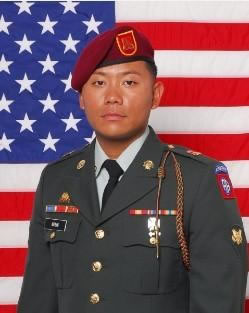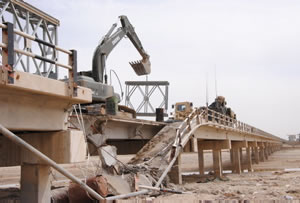March 15, 2010
One last thing
Sorry, but I can't quite leave this alone yet. One more thing needs to be said.
 This is Sgt. Ian Gelig, aged 25, of the 782nd Brigade Support Battalion, 4th Brigade Combat Team, 82nd Airborne Division. On March 1, he died in Afghanistan. A California native, he is survived by his parents and two sisters. He had been in Afghanistan since early last fall; he had previously done 15 months in Iraq. He had just made sergeant.
This is Sgt. Ian Gelig, aged 25, of the 782nd Brigade Support Battalion, 4th Brigade Combat Team, 82nd Airborne Division. On March 1, he died in Afghanistan. A California native, he is survived by his parents and two sisters. He had been in Afghanistan since early last fall; he had previously done 15 months in Iraq. He had just made sergeant.
Gelig, a driver by trade, was in a convoy headed north on Highway 4, one of the busiest highways in Afghanistan, connecting the entire south of the country with the Pakistani border. Around 7 am local time, while he was crossing the bridge over the Tarnak River, halfway between Kandahar Air Field and Kandahar City, a suicide bomber somehow got his car close to the rolling convoy and detonated, killing Gelig.
 Whether the suicide bomber had intended it or not, the massive explosion also knocked the side out of the bridge, limiting civilian and military traffic on this crucial artery for an extended period, and undoubtedly damaging local commerce over a wide area of the south. (Several Afghan civilians were killed in the blast, as well.)
Whether the suicide bomber had intended it or not, the massive explosion also knocked the side out of the bridge, limiting civilian and military traffic on this crucial artery for an extended period, and undoubtedly damaging local commerce over a wide area of the south. (Several Afghan civilians were killed in the blast, as well.)
The attack occurred very close to an Afghan police checkpoint, one of several along this highway. It is not known whether the attacker had lain in wait for long, or had just arrived around the same time as the American convoy was passing. But suicide vehicles are a risk on busy streets throughout Afghanistan. Highway 4 is too busy with ISAF, ANSF, and civilian traffic (not to mention air traffic overhead) for insurgents to lay IEDs the way it's done elsewhere: so fatal attacks in this area on Afghan and Western personnel tend to be suicide vehicle-borne in nature.
The police in this area are reported to be mentored by a U.S. Police Mentoring Team (PMT) from the 97th Military Police Battalion. U.S. PMTs are often responsible for a broad area, moving between multiple locations. It isn't known how often they were able to observe ANP performance at the bridge, or whether any were present when the fatal early morning attack occurred. It must be noted that PMTs cannot order Afghan police to do anything. They are not their commanders. They can help Afghan police who want to be helped, and they can report on any problems they observe back to ISAF. It is not known what the PMT's opinion of this particular police checkpoint was, either.
In any case, this checkpoint was one of the highest-profile police posts in southern Afghanistan. ISAF senior officers drive over it every day to get into the city or back out. So do Afghan army generals and police commanders, along with thousands of regular Afghans. And Afghan commanders don't mind getting out of their cars if they see soldiers or police slacking off. ISAF and ANSF convoys are rolling past them every few minutes. Base defence soldiers from the British RAF Regiment, who patrol the surrounding area, undoubtedly had them under observation from time to time as well. So if this police checkpoint was significantly more poorly manned than most for any extended period, it likely would have been noticed and corrected.
The 97th MP Battalion is reported to be attached to Task Force Kandahar, the Canadian brigade-level headquarters in this area. (So for that matter is the battalion of the 4th BCT, 2nd/508th, that Sgt. Gelig's unit likely would have been driving in support of most of the time.) Its commander, BGen Menard, or his representative, was undoubtedly at the departure ceremony for Sgt. Gelig, just as he would have been if it was a Canadian soldier. IED attacks are not picky as to ISAF nationality, and one nation's mine-resistant vehicle looks pretty much like another when you're a suicide focussed on your last few seconds of life.
I'm sure the commander of the 97th Battalion, and the commander of Task Force Kandahar, and the commander of the local ANP for that matter, are all concerned in their own ways about the ability of the Afghan security forces to keep the highways free of suicide cars. All three of them drive that stretch of road regularly themselves, so I'm sure they and their staffs are doing all they can. But as others have observed before me, with suicide bombers, the defender has to be on the bounce all the time, and the attacker needs to only be right once. And that would be a hard burden for any country's security forces.
Sgt. Gelig's death was a tragedy, just like all the other fatal suicide car attacks in Afghanistan were. We want to blame someone, but all we have is some nameless "martyr" and his faceless, evil handlers. In the civilian world, it would be easy for us to turn our anger inward, and litigate and blame and attack. But soldiers aren't normally afforded that luxury. Soldiers do what they're told, and drive down the roads they're told to.
I counted: I've driven over that same stretch of road 16 times in all. Others have done it a lot more. If you told me there's a Canadian who'd been over it 500 times, I wouldn't be at all surprised. It was pure random chance that most of us are alive today, and Sgt. Gelig is not. But another soldier will have undoubtedly taken his place by now, and be driving where he would have driven, just as he would have, and continue obeying those orders, just as he would have, and when his tour is done that driver will also be replaced, and so this massive allied effort will continue until this war is over, and all the individual sacrifices can be weighed in the balance with the peace that they brought. That is the consolation, the pitifully small consolation.
We are a learning army: any lessons or corrections to make our enemy's job harder than it was in this case will undoubtedly be hoisted in in due time. But if we want to do this right we should be remembering Sgt. Gelig today as a good driver and a good soldier, who gave everything a soldier can give, and leaving our trivial little political concerns out of it. Were the situation reversed, I think that's what I would have wanted. I hope his family can find peace.
Other posts on this incident: 1 -- 2 -- 3 -- 4 -- 5 -- 6 -- 7
"endearingly macho" -- Mark Steyn
"wonderfully detailed analysis" -- John Allemang, Globe and Mail
"unusually candid" -- Tom Ricks, Foreignpolicy.com
May 2010
April 2010
March 2010
February 2010
January 2010
December 2009
November 2009
October 2009
September 2009
August 2009
July 2009
News:
The Globe and Mail
The Star
The Wash. Post
Opinion:
TNR
Slate
Washington Monthly
Rants:
Canadians
Penny
Janes
Cosh
The Hound
Coyne
Wells
Farrell, etc.
Steyn
Levant
Afghanistan
The Torch
Abu M.
Bill & Bob
Ghosts of Alex
Registan
Jari
Ink Spots
Ackerman
Kings
FRI
Embedded
Milnews.ca
Can-AFG
The Capt.
Etc.
TMLutas
Sullivan
Marshall
Kaus
Lileks
Reynolds
Welch
Farber
The Shark
Breen
Henley
Electrolite
Samizdata
Slotman
Simberg
Northrup
Bryant
Yglesias
Cole
Drum
Clients/Employers
(Past and Present):
U of T
Cdn. Forces
CG Magazine
LRC
Adrenaline Vault
